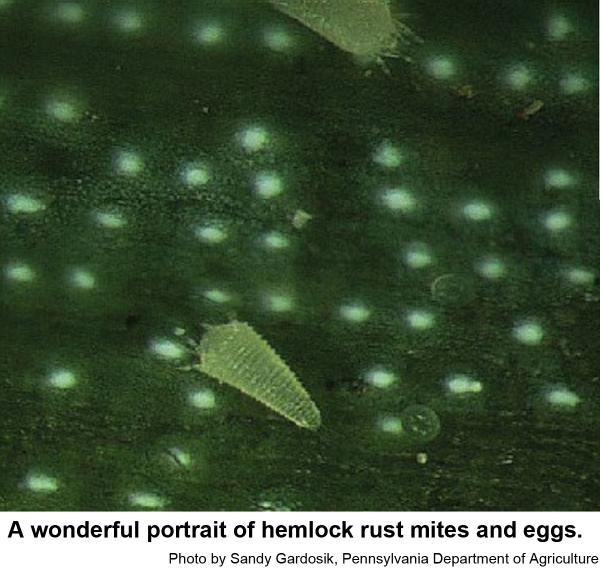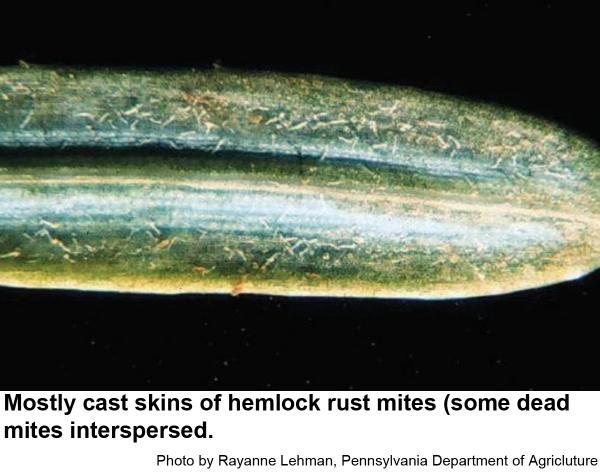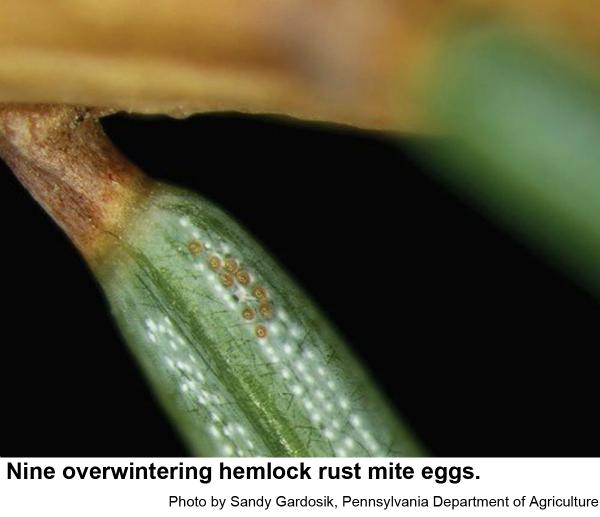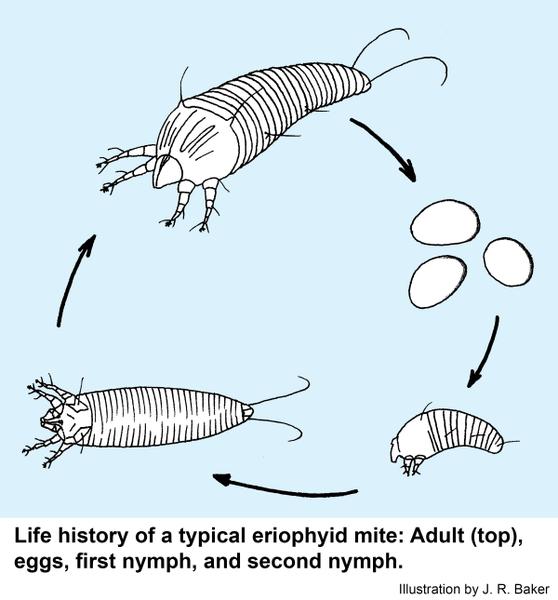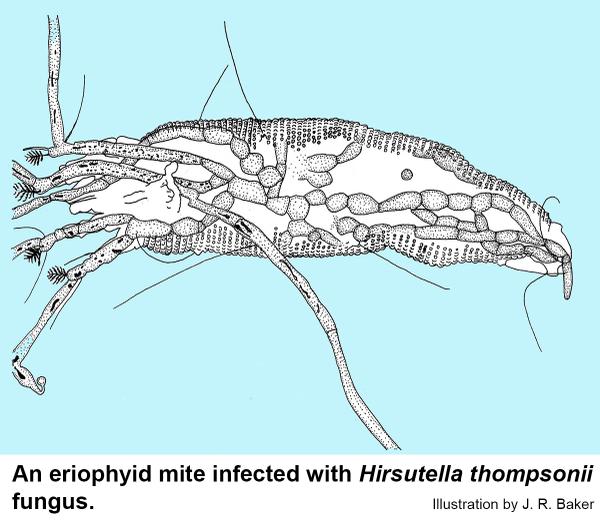Description and Biology
The hemlock rust mite, Nalepella tsugifoliae, is a virtually microscopic mite in the family Eriophyidae that includes gall mites and bud mites. Hemlock rust mites are "vagrants" because they crawl about on the surface on hemlock needles and bark. They do not cause galls and do not wedge into buds. Females do overwinter in bark cracks. These yellowish to reddish-orange mites have only four legs. They are shaped more or less like the snack food 'Bugles' with the mouthparts and legs all at the wide end. They feed on the needles of hemlock all year, but build up to great numbers in cool, dry springs. Females lay comparitively large eggs from which hatch first nymphs. Eggs are off-white but overwintering eggs are reddish to tan, laid in clusters. First nymphs molt into second nymphs that in a few days molt into new adults. Because they are so small, their tiny mouthparts can only pierce the epidermis. They inject saliva and suck out the predigested plant juice. A tiny pale spot forms at each feeding puncture. The nymphal cast skins are white and contribute to the grayish appearance of heavily infested hemlocks.
Host Plants
Eriophyid mites are usually host specific. The hemlock rust mite feeds on hemlock so there is no danger that it might spread to other plants (although it has been reported from fir.). Heavily infested hemlocks turn yellowish to grayish (spruce spider mites cause hemlocks to bronze) before the needles drop prematurely. Because hemlock rust mites are most abundant in spring, later new growth may be unaffected.
Residential Recommendations
Phytoseiid mites feed on hemlock rust mites as do certain lady beetles and lacewing insects. In addition, a parasitic fungus, Hirsutella thompsonii, devastates rust mite populations when the weather is warm and humid. Hemlock rust mites are sensitive to Sevin insecticide. A horticultural oil should give adequate control as well. The Hemlock Pest Management Calendar gives some idea as to when to scout for various pests of hemlock.
Other Resources
- Eriophyid Rust and Sheath Mites. Rajotte, E. 2017 (update). PennState Extension.
- Hemlock Pest Management Calendar. Frank, S. and J. R. Baker. 2019. Entomology Insect Notes, NC State Extension Publications.
- Hemlock Rust Mite. Krischik, V. and J. Davidson. 2013 (last modified). IPM (Integrated Pest Management) of Midwest Landscapes, Pests of Trees and Shrubs. page 146.
- Hemlock Rust Mite. Nixon, P. 2008. Home, Yard & Garden Pest Newsletter, University of Illinois Extension.
- Horticultural Oils for Ornamental Plants. Frank, S., J. R. Baker and S. B. Bambara. 2018. Entomology Insect Notes, NC State Extension Publications.
- Lacewings. Walgenbach, J. 2015. NC State Extension Publications.
- Lady Beetles in the Landscape. Frank, S. and J. R. Baker. 2020 (revised). Entomology Insect Notes, NC State Extension Publications.
- Extension Plant Pathology Publications and Factsheets
- Horticultural Science Publications
- North Carolina Agricultural Chemicals Manual
For assistance with a specific problem, contact your local N.C. Cooperative Extension center.
This Factsheet has not been peer reviewed.
Publication date: Feb. 5, 2019
Reviewed/Revised: Nov. 9, 2023
Recommendations for the use of agricultural chemicals are included in this publication as a convenience to the reader. The use of brand names and any mention or listing of commercial products or services in this publication does not imply endorsement by NC State University or N.C. A&T State University nor discrimination against similar products or services not mentioned. Individuals who use agricultural chemicals are responsible for ensuring that the intended use complies with current regulations and conforms to the product label. Be sure to obtain current information about usage regulations and examine a current product label before applying any chemical. For assistance, contact your local N.C. Cooperative Extension county center.
N.C. Cooperative Extension prohibits discrimination and harassment regardless of age, color, disability, family and marital status, gender identity, national origin, political beliefs, race, religion, sex (including pregnancy), sexual orientation and veteran status.

